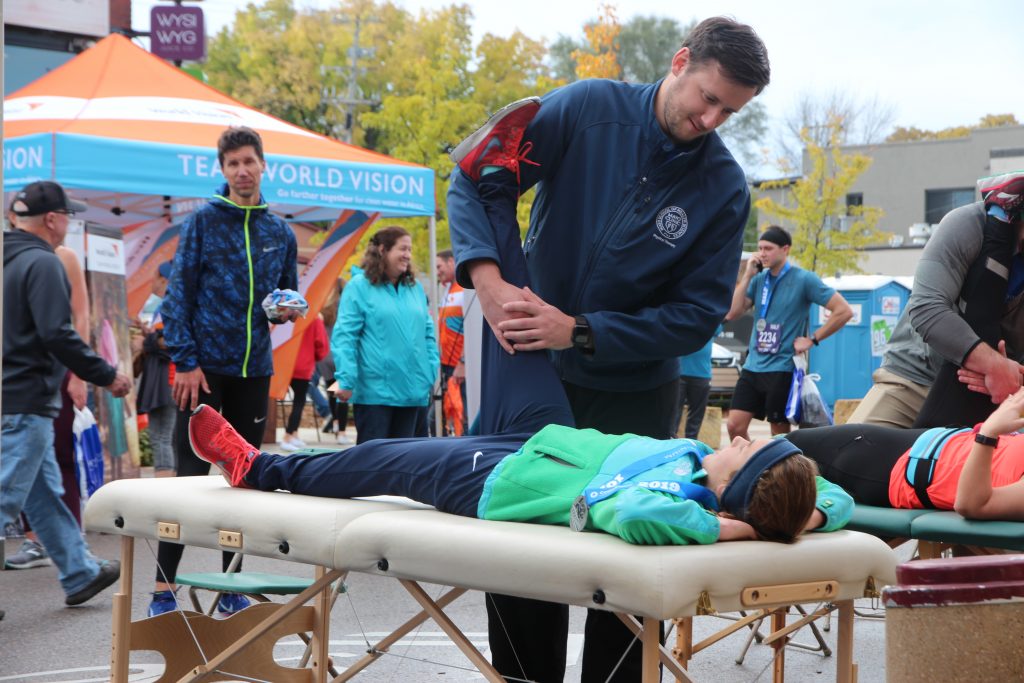Mankato Marathon Recovery Room
Top running injuries: Recognize the problem and learn how to best recover
Like any physical activity, running (any distance) carries with it a risk for injury. Whether you’re a first-time runner or a seasoned marathoner, youmay develope one of these injuries at some point. That’s why it helps to know what steps you can take to help rehab these running injuries on your own, and when it’s time to call in the pros before things get any worse.
No matter the severity of a running injury, the end goal should be to seek the right treatment and work to get back on your feet and move again.

Patellofemoral (puh-tel-o-FEM-uh-rul) pain syndrome is pain at the front of your knee, around your kneecap (patella). Sometimes called “runner’s knee,” it’s more common in people who participate in sports that involve running and jumping. The knee pain often increases when you run, walk up or down stairs, sit for long periods, or squat.
What you can do on your own
-
- R.I.C.E.
- Rest and take a break from running. Return to running with a gradual increase in intensity.
- Ice the knee for up to 20 minutes at a time, 3-4 times a day.
- Compress the knee with an elastic bandage or knee sleeve to limit swelling
- Elevate the knee above the level of your heart, especially at night, to reduce swelling.
- Stretch and strengthen the quadriceps and gluteal muscles. These activities should be pain free during completion.
- Use over-the-counter arch support orthotics.
- Take acetaminophen or topical/oral NSAIDs as needed for pain and swelling. Follow listed medication recommendations with any over-the-counter remedy.
- Cross-train
- If running is your primary activity and it hurst to do so, give it a rest and stay active with a different activity such as biking or swimming.
- R.I.C.E.
When to see the doctor
-
- Symptoms not improving after several days or not resolving with the above
- Significant swelling in the knee
- Inability to bear weight
- Mechanical symptoms including catching, locking, or your knee “giving out.”
Achilles tendinitis is an overuse injury of the Achilles (uh-KILL-eez) tendon, the band of tissue that connects calf muscles at the back of the lower leg to your heel bone.
Achilles tendinitis most commonly occurs in runners who have suddenly increased the intensity or duration of their runs. It’s also common in middle-aged people who play sports, such as tennis or basketball, only on the weekends.
What you can do on your own
-
- I.C.E.
- Rest and take a break from running. Return to running with a progressive increase in distance and frequency when pain has improved.
- Ice the area of pain, up to 20 minutes at a time, 3-4 times a day.
- Compress the area with an elastic bandage to limit swelling.
- Elevate the leg above the level of your heart, especially at night, to reduce swelling.
- Gently stretch and strengthen the calf.
- Take acetaminophen or topical/oral NSAIDs as needed for pain and swelling. Follow listed medication recommendations with any over-the-counter remedy.
- Cross-train
- If running is your primary activity and it hurts to do so, give it a rest and stay active with a different activity such as biking or swimming.
- I.C.E.
-
- Symptoms not improving after several days or not resolving with the above.
- Pain limiting daily activities.
- Weakness or significant bruising or swelling.
A hamstring injury occurs when you strain or pull one of your hamstring muscles — the group of three muscles that run along the back of your thigh.
You may be more likely to get a hamstring injury if you play a sport that involves sprinting with sudden stops and starts. However, a hamstring injury can easily occur in runners.
What you can do on your own
-
- I.C.E.
- Rest and take a break from running. Return to running with a progressive increase in distance and frequency when pain has improved.
- Ice the area of pain, 20 minutes at a time, 3-4 times a day.
- Compress the area with an elastic bandage to limit swelling.
- Elevate the leg above the level of your heart, especially at night, to reduce swelling.
- Gradually return to running when pain free with normal day-to-day activities.
- Take acetaminophen or topical/oral NSAIDs as needed for pain and swelling. Follow listed medication recommendations with any over-the-counter remedy.
- Cross-train
- If running is your primary activity and it hurts to do so, give it a rest and stay active with a different activity such as biking or swimming.
- I.C.E.
-
- Symptoms not improving after several days or not resolving with the above.
- Hearing or feeling a “pop” or a “snap” with sudden onset of pain in the buttock or back of the thigh.
- Significant bruising or noticeable deformity in the back of the thigh.
- Weakness in knee bending.
- Inability to bear weight.
Plantar fasciitis (PLAN-tur fas-e-I-tis) is one of the most common causes of heel pain. It involves inflammation of a thick band of tissue that runs across the bottom of your foot and connects your heel bone to your toes (plantar fascia).
Plantar fasciitis commonly causes stabbing pain that usually occurs with your first steps in the morning. As you get up and move, the pain normally decreases, but it might return after long periods of standing or when you stand up after sitting.
What you can do on your own
-
- Take a break from running. Return to running with a progressive increase in distance and frequency when pain has improved. Avoid running through increasing pain.
- Ice the area of pain, 20 minutes at a time, 3-4 times a day. Freezing a plastic water bottle and rolling it under the arch of the foot can be helpful.
- Gently stretch the calf and plantar fascia.
- Use over-the-counter arch support orthotics or cushioned heel pads.
- Take acetaminophen or oral/topical NSAIDs as needed for pain and swelling. Follow listed medication recommendations with any over-the-counter remedy.
-
- Symptoms not improving with the above options.
- Feeling a “pop” or a “snap” with sudden onset of worsening pain on the bottom of the foot.
- Inability to bear weight on the foot.
The term “shin splints” refers to pain along the shin bone (tibia) — the large bone in the front of your lower leg. Shin splints are common in runners, dancers and military recruits.
Medically known as medial tibial stress syndrome, shin splints often occur in athletes who have recently intensified or changed their training routines. The increased activity overworks the muscles, tendons and bone tissue.
What you can do on your own
-
- R.I.C.E.
- Rest and take a break from running. Return to running with a progressive increase in distance and frequency when pain has improved. Avoid running through increasing pain.
- Ice the area of pain, 20 minutes at a time, 3-4 times a day.
- Compress the area with an elastic bandage to limit swelling.
- Elevate the leg above the level of your heart, especially at night, to reduce swelling.
- Stretch and strengthen massage the calf and shin muscles.
- Use over-the-counter arch support orthotics.
- Take acetaminophen or topical/oral NSAIDs as needed for pain and swelling. Follow listed medication recommendations with any over-the-counter remedy.
- Cross-train
- Give running a rest and stay active with a different activity such as biking or swimming.
- R.I.C.E.
-
- Symptoms not improving after several days or not resolving with the above.
- Pain occurring at rest and without running.
- Notable bruising or swelling in the shin.
- Inability to bear weight.
This occurs when the tough band of tissue that extends from the outside of your hip to the outside of your knee (iliotibial band) becomes so tight that it rubs against the outer portion of your femur. Distance runners and cyclists are especially susceptible to iliotibial band syndrome.
What you can do on your own
-
- Rest, up to 1-2 weeks may be required. Trying to push through the pain can prolong recovery.
- Strengthen your core and gluteal muscles. This can be done with side lying leg lifts, clam shells, and double- vs single-leg squats. Avoid exercises that make the symptoms worse.
- Apply ice or heat over the hip and thigh.
- Take acetaminophen or topical/oral NSAIDs as needed for pain and swelling. Follow listed medication recommendations with any over-the-counter remedy.
-
- Symptoms not resolving after several days or not resolving with the above.
Stress fractures are tiny cracks in a bone. They’re caused by repetitive force, often from overuse — such as repeatedly jumping up and down or running long distances. Stress fractures can also develop from normal use of a bone that’s weakened by a condition such as osteoporosis.
What you can do on your own
-
- Rest, up to 1-2 weeks may be required.
- Limit weight bearing through the injured leg.
- Ice the area of pain, 20 minutes at a time, 3-4 times a day.
- Elevate the area above the level of your heart, especially at night, to reduce swelling. Don’t try to exercise through the pain which can progress the injury from a stress reaction to a full stress fracture.
- Take acetaminophen or topical/oral NSAIDs as needed for pain and swelling. Follow listed medication recommendations with any over-the-counter remedy.
-
- Notable swelling or bruising.
- Significant pain that occurs at rest and not only with activity.
- Inability to bear weight.




